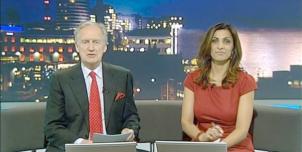Full Freeview on the Sutton Coldfield (Birmingham, England) transmitter
| Google Streetview | Google map | Bing map | Google Earth | 52.600,-1.835 or 52°36'1"N 1°50'5"W | B75 5JJ |
The symbol shows the location of the Sutton Coldfield (Birmingham, England) transmitter which serves 1,870,000 homes. The bright green areas shown where the signal from this transmitter is strong, dark green areas are poorer signals. Those parts shown in yellow may have interference on the same frequency from other masts.
This transmitter has no current reported problems
The BBC and Digital UK report there are no faults or engineering work on the Sutton Coldfield (Birmingham, England) transmitter._______
Digital television services are broadcast on a multiplexes (or Mux) where many stations occupy a single broadcast frequency, as shown below.
64QAM 8K 3/4 27.1Mb/s DVB-T MPEG2
DTG-12 QSPK 8K 3/4 8.0Mb/s DVB-T MPEG2
H/V: aerial position (horizontal or vertical)
Which Freeview channels does the Sutton Coldfield transmitter broadcast?
If you have any kind of Freeview fault, follow this Freeview reset procedure first.Digital television services are broadcast on a multiplexes (or Mux) where many stations occupy a single broadcast frequency, as shown below.
64QAM 8K 3/4 27.1Mb/s DVB-T MPEG2
DTG-12 QSPK 8K 3/4 8.0Mb/s DVB-T MPEG2
H/V: aerial position (horizontal or vertical)
Which BBC and ITV regional news can I watch from the Sutton Coldfield transmitter?

BBC Midlands Today 2.9m homes 10.9%
from Birmingham B1 1RF, 15km south-southwest (200°)
to BBC West Midlands region - 66 masts.

ITV Central News 2.9m homes 10.9%
from Birmingham B1 2JT, 15km south-southwest (201°)
to ITV Central (West) region - 65 masts.
All of lunch, weekend and 80% evening news is shared with Central (East)
Are there any self-help relays?
| Burton (shobnall) | Transposer | 1 km W Burton-on-Trent | 60 homes |
| Coalville | Transposer | 18 km NW Leicester | 600 homes |
| Solihull | Transposer | Land Rover building | 400 homes |
How will the Sutton Coldfield (Birmingham, England) transmission frequencies change over time?
| 1950s-80s | 1984-97 | 1997-98 | 1998-2011 | 2011-13 | 7 Mar 2018 | ||||
| VHF | B E T | B E T | B E T | B E K T | W T | ||||
| C4 | BBCtvwaves | ||||||||
| C33 | com7 | ||||||||
| C35 | com8 | ||||||||
| C36 | LOCAL2 | ||||||||
| C39 | +ArqB | ArqB | |||||||
| C40 | BBC2waves | BBC2waves | BBC2waves | +BBCB | BBCB | ||||
| C42 | SDN | SDN | |||||||
| C43 | ITVwaves | ITVwaves | ITVwaves | BBCA | BBCA | ||||
| C45 | ArqA | ArqA | |||||||
| C46 | BBC1waves | BBC1waves | BBC1waves | D3+4 | D3+4 | ||||
| C48 | _local | ||||||||
| C50tv_off | C4waves | C4waves | C4waves | ||||||
| C51tv_off | LB | ||||||||
| C55tv_off | com7tv_off | ||||||||
| C56tv_off | COM8tv_off |
tv_off Being removed from Freeview (for 5G use) after November 2020 / June 2022 - more
Table shows multiplexes names see this article;
green background for transmission frequencies
Notes: + and - denote 166kHz offset; aerial group are shown as A B C/D E K W T
waves denotes analogue; digital switchover was 7 Sep 11 and 21 Sep 11.
How do the old analogue and currrent digital signal levels compare?
| Analogue 1-4 | 1000kW | |
| SDN, ARQA, ARQB, BBCA, D3+4, BBCB | (-7dB) 200kW | |
| com7 | (-10.5dB) 89.2kW | |
| com8 | (-10.7dB) 86kW | |
| LB | (-20dB) 10kW | |
| Mux 1*, Mux 2*, Mux A*, Mux B*, Mux C*, Mux D* | (-21dB) 8kW |
Which companies have run the Channel 3 services in the Sutton Coldfield transmitter area
|
|
Thursday, 5 May 2011
M
Mike Dimmick6:46 PM
Ian Brown: A longer run of cable will drop more signal than a shorter one. One TV might be more or less sensitive than the other one.
If you're going to split an aerial feed to more than one location, you should put the split as close to the aerial as possible. Don't run the cable to the back of one TV and split it there - you've already lost a significant amount of signal before it gets to the first point, and the cable run is likely to be longer than taking a second cable directly from the aerial.
Standard 'low-loss' coax cable is anything but. Use satellite-grade cable (dense copper braid over copper foil screening) to reduce the amount of signal lost in the cable.
Use proper splitters - don't just wire multiple cables into the aerial, because it will no longer be properly matched. If the cables aren't properly matched, you get reflections bouncing up and down the cable. There is some insertion loss just from using the splitter - if this is losing too much signal for one TV, you might need to add a small amplifier to offset this loss.
If it was working fine before switchover, and the non-working TV is on the shorter cable run, you could have too much signal. If you have an amplified splitter, try turning the amplifier down or removing the amp entirely.
| link to this comment |
M
Mike Dimmick6:52 PM
James Mooney: Does BBC Four work? Before switchover, Sky Sports channels are carried on Multiplex B.
If you're north of Birmingham, or your aerial points in the same direction as the Emley Moor transmitter, you could be getting interference from Emley Moor BBC Two (analogue) when the weather conditions are right or at night.
| link to this comment |
N
N Omara 7:49 PM
The hd freeview signal comes from Lichfield / hints at the moment and will transfer to Sutton coldfield only in September . Sutton does not have the digital signal I understand
| link to this comment |
Friday, 6 May 2011
D
Daz9:16 AM
Leicester
Jessie P / N Omara
Thanks for your responses. What I'm trying to understand is what could have changed when I've been receiving HD channels faultlessly for 5 months and now nothing at all, not a hint of a signal although all other channels are as before. My home setup hasn't altered. Aerial is on the roof and only recently fitted for freeview reception.
Thanks again
Daz
| link to this comment |
Daz's: mapD's Freeview map terrainD's terrain plot wavesD's frequency data D's Freeview Detailed Coverage
I
Ian Brown2:20 PM
Mike D
Many thanks for your very positive response to my problem, it is much appreciated. It gives me a few things to be going at. The aerial and splitter that I have were installed a couple of years ago by a very reputable local aerial company. They also added an amplifier for the TV that is giving me the problems (I will try removing this to see what happens). I can always get back to them in the light of your suggestions to see if they can fix the problem.
What puzzles me though is that before the Nottingham changeover, both TVs tuned in to ALL of the Freeview channels, with excellent reception. It was only after the Nottingham transmitter switched that this problem began.
Yet I always thought that Kimberley was a relay for Sutton Coldfield (not Nottingham), and wondered if all the engineering works now taking place there might, in some way, be to blame.
| link to this comment |
M
Mike Dimmick5:04 PM
Ian Brown: Nottingham (Kimberley) was a relay of Waltham for analogue services. That is, it received the signal off-air from Waltham and rebroadcast it on different frequencies.
It wasn't possible to do this for digital as the signal from Waltham simply wouldn't reach that far (particularly as the power levels were originally half what they are now). Instead, Nottingham - serving a major town, significant for advertisers and to secure subscriptions for the original onDigital service - was fed independently by leased line, with satellite as a backup.
As it was fed independently, it was possible to switch Nottingham over before its former parent, or indeed any other transmitters in the region.
The fact that everything worked fine before switchover points to having too much signal. Amplifiers and tuners can only handle so much signal before distorting, and that distortion causes errors. The signal contains redundant information so that the box can correct many of those errors, but once the threshold amount of errors has been exceeded it can no longer correct them, and you get sound breaks and picture break-up.
Signal levels do vary naturally over time - this is nothing to do with the transmitter, all to do with signal propogation from the transmitter. This is why it can work sometimes, but not reliably.
| link to this comment |
T
Teresa9:32 PM
Had new digital aerial fitted with amplifier etc.Engineers stated due to distance from Sutton Coldfield area [I live in Studley, Warks and on busy A435] will get some interference. This is happening especially when traffic is bad and also when I put on certain electrical appliances. Lads said would be ok after September switchover, is this correct. Also bought cheao freeview box, would a better one help?
| link to this comment |
K
KMJ,Derby10:45 PM
Teresa: after switchover in September the signals will be 25 times stronger so yes the engineer is correct in saying that things will improve. You might find that you end up with too much signal and have to remove the amplifier.Although some models of freeview box claim to deal with interference better than others there is really no solution to the situation where the interference is stronger than the required signal.Positioning the aerial so that the house or chimney stack act as a screen to interference from traffic can help, and using good quality fly leads is essential when interference from household appliances or switches is a problem.A mains filter can help with interference within the home. You might decide it is better to wait a few weeks for switchover then see what the situation is like.
| link to this comment |
Saturday, 7 May 2011
G
george ball5:46 PM
Cannock
aerial is positioned on the roof.
| link to this comment |
george's: mapG's Freeview map terrainG's terrain plot wavesG's frequency data G's Freeview Detailed Coverage
I
Ian Brown6:20 PM
Mike D
Thank you once again for your most informative, and interesting, reply to my last post.
I'm sure I'll soon have both TV sets running as they should, with the helpful advice you have given me.
| link to this comment |
Select more comments
Your comment please!





